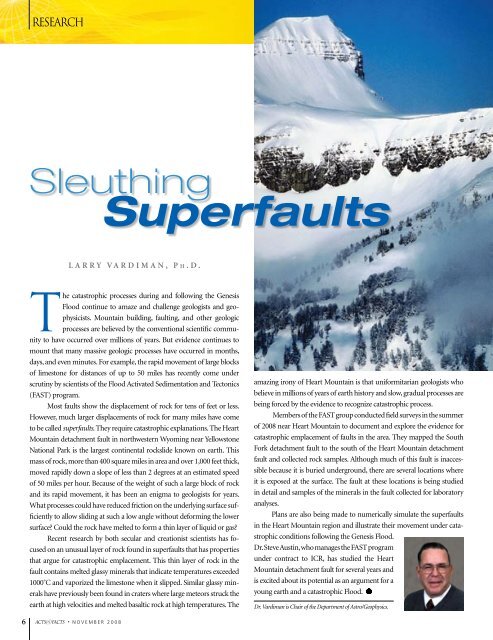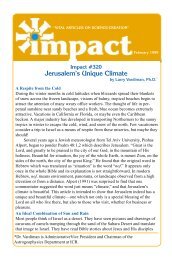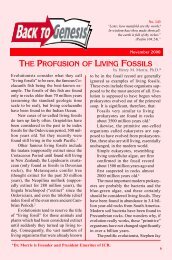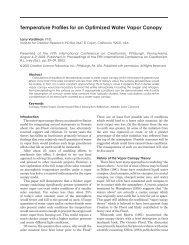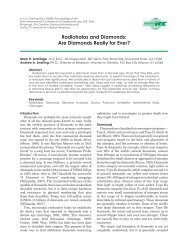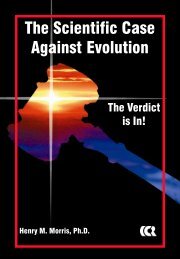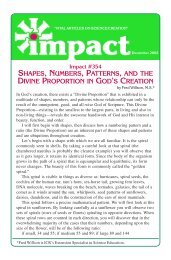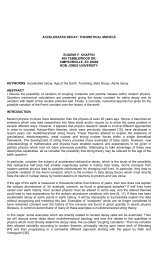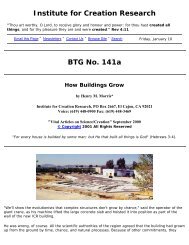Acts & Facts - Institute for Creation Research
Acts & Facts - Institute for Creation Research
Acts & Facts - Institute for Creation Research
Create successful ePaper yourself
Turn your PDF publications into a flip-book with our unique Google optimized e-Paper software.
RESEARCHSleuthingSuperfaultsLarry Vardiman, Ph . D .The catastrophic processes during and following the GenesisFlood continue to amaze and challenge geologists and geophysicists.Mountain building, faulting, and other geologicprocesses are believed by the conventional scientific communityto have occurred over millions of years. But evidence continues tomount that many massive geologic processes have occurred in months,days, and even minutes. For example, the rapid movement of large blocksof limestone <strong>for</strong> distances of up to 50 miles has recently come underscrutiny by scientists of the Flood Activated Sedimentation and Tectonics(FAST) program.Most faults show the displacement of rock <strong>for</strong> tens of feet or less.However, much larger displacements of rock <strong>for</strong> many miles have cometo be called superfaults. They require catastrophic explanations. The HeartMountain detachment fault in northwestern Wyoming near YellowstoneNational Park is the largest continental rockslide known on earth. Thismass of rock, more than 400 square miles in area and over 1,000 feet thick,moved rapidly down a slope of less than 2 degrees at an estimated speedof 50 miles per hour. Because of the weight of such a large block of rockand its rapid movement, it has been an enigma to geologists <strong>for</strong> years.What processes could have reduced friction on the underlying surface sufficientlyto allow sliding at such a low angle without de<strong>for</strong>ming the lowersurface? Could the rock have melted to <strong>for</strong>m a thin layer of liquid or gas?Recent research by both secular and creationist scientists has focusedon an unusual layer of rock found in superfaults that has propertiesthat argue <strong>for</strong> catastrophic emplacement. This thin layer of rock in thefault contains melted glassy minerals that indicate temperatures exceeded1000˚C and vaporized the limestone when it slipped. Similar glassy mineralshave previously been found in craters where large meteors struck theearth at high velocities and melted basaltic rock at high temperatures. Theamazing irony of Heart Mountain is that uni<strong>for</strong>mitarian geologists whobelieve in millions of years of earth history and slow, gradual processes arebeing <strong>for</strong>ced by the evidence to recognize catastrophic process.Members of the FAST group conducted field surveys in the summerof 2008 near Heart Mountain to document and explore the evidence <strong>for</strong>catastrophic emplacement of faults in the area. They mapped the SouthFork detachment fault to the south of the Heart Mountain detachmentfault and collected rock samples. Although much of this fault is inaccessiblebecause it is buried underground, there are several locations whereit is exposed at the surface. The fault at these locations is being studiedin detail and samples of the minerals in the fault collected <strong>for</strong> laboratoryanalyses.Plans are also being made to numerically simulate the superfaultsin the Heart Mountain region and illustrate their movement under catastrophicconditions following the Genesis Flood.Dr. Steve Austin, who manages the FAST programunder contract to ICR, has studied the HeartMountain detachment fault <strong>for</strong> several years andis excited about its potential as an argument <strong>for</strong> ayoung earth and a catastrophic Flood.Dr. Vardiman is Chair of the Department of Astro/Geophysics.6 ACTS&FACTS • NOVEMBER 2008


